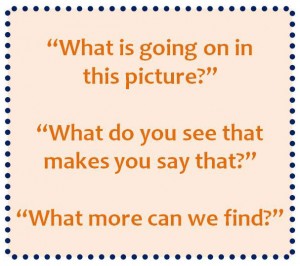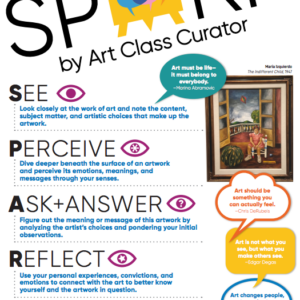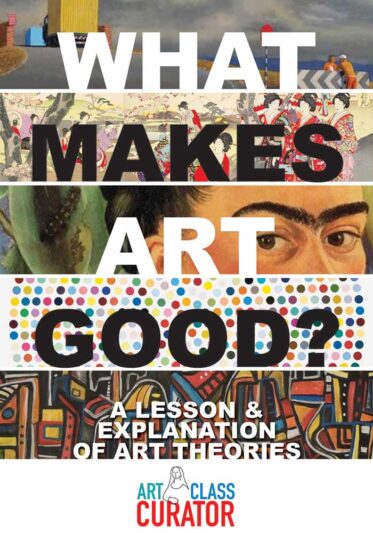One of the main goals of my career has been to help people become more comfortable looking at and talking about art as well as help them understand the value that art has one their lives. The #1 comment I get when I tell people I am an art teacher is “I can’t draw.” I have lots of issues with this. First. No, I don’t believe that. Yes, you can. Everyone except those with certain disabilities can draw. The best way to get better at drawing is to draw more. But more importantly for me, I want everyone to understand that are is more than just drawing well.
Art is about:
- looking closely
- understanding life and the human spirit
- connecting to the past
- connecting to other cultures
- thinking critically and solving problems
- knowing ourselves deeply
- feeling and expressing

Free Poster
What Do Kids Learn from Looking at Art Poster
Our students learn so much from looking at art. Use this poster in your classroom to remind them of all the skills they’re growing!
The everyday person feels inept and ill-prepared at looking at and understanding art. They feel like there is something that people who enjoy art have that they themselves don’t. This is partly because of the elitism formed around art and the art world for a good part of the 20th century. I am here to tell you that art is for everyone. You, as you are today, are fully capable of experiencing art for yourself.
Young children on the other hand don’t come with these hesitancies and blocks. They accept art and enjoy it for what it is. Your first goal when talking about art with your kids: be more like them!
Below I have included some tips on how to talk to your kids about art, especially breaking out a painting or sculpture from a museum, book, or the internet and leading a discussion with your kid about it.
In a future post, I will write about ways to integrate artworks into your core curriculum. This post is about looking at works of art for the sake of experiencing art.
- Your (or your child’s) meaning isn’t any less true or valid than the artist’s meaning. It doesn’t matter what the museum labels, the Wikipedia pages, or the textbooks say. Art becomes yours when you look at it. What do you think? You don’t need to know anything about the work to enjoy it.
- Don’t give away the “answers” before the kids have a chance to find them for themselves. As an art teacher, I hate nothing more than a PowerPoint with an artwork with a bunch of descriptive text right next to it. You must let the student figure out the information for herself by looking at and experiencing the artwork. If you give away all of the information at the beginning, your student is less likely to enjoy the work, remember it, or learn from it. Knowledge that is formed through experience is more likely to stick.
 Use open-ended questions or use a critical analysis strategy. That sounds a lot scarier than it is. One option is using something called Visual Thinking Strategies. With VTS, you use three questions only: “what’s going on? What do you see that makes you say that? And what more can you find?” That’s it! You basically just keep poking and prodding the student for more information and connecting his or her ideas together. I plan on writing a post about this in the future. Another option is art criticism using the steps of description, analysis, interpretation, and evaluation. This is a more regimented process when you don’t know exactly where to start. By focusing on description and analysis at the beginning, it gives you a chance to see and notice every detail. Click here for more information about these steps.
Use open-ended questions or use a critical analysis strategy. That sounds a lot scarier than it is. One option is using something called Visual Thinking Strategies. With VTS, you use three questions only: “what’s going on? What do you see that makes you say that? And what more can you find?” That’s it! You basically just keep poking and prodding the student for more information and connecting his or her ideas together. I plan on writing a post about this in the future. Another option is art criticism using the steps of description, analysis, interpretation, and evaluation. This is a more regimented process when you don’t know exactly where to start. By focusing on description and analysis at the beginning, it gives you a chance to see and notice every detail. Click here for more information about these steps.- Try new ways to experience the art. Have fun with it! Act out the painting, pose like the characters, write a poem about the artwork, or play an I-spy game. Try new ways to connect, and don’t be afraid to experiment!
I honestly could go on all day about this. I have a lot more blog posts to write.

Free Worksheets!
SPARK Art Criticism Framework
SPARK is a complete art criticism and discussion framework that ignites deeper student art connections and more engaging classroom art discussions. Download these free SPARK posters plus a worksheet to use in your classroom!
Please share your experiences looking at and discussing art with your kids in the comments. What has worked for you?






Love these tips!
Thanks! 🙂
Thank you so very much for sharing these very wonderful artists’ works with me, a homeschooling mom. I can’t wait to use these with my kiddos. I love Mary Cassatt; she’s one of my favorite artists. Thank you for the tips about everyone being able to look and wonder about art. You are a blessing to my home school. I wish you and your precious family a wonderful day!! Thank you, Leanne from Michigan
Thank you so much! I’m so happy your are finding my resources useful. 🙂
Hi-when I tried to confirm the newsletter I received an error. I’d really love to see the free Art Appreciation bundle.
I just resent the confirmation to you. Let me know if it didn’t work. Be sure to check the promotions/updates/spam tabs as well just in case.
Excuse me, are Visual Thinking Strategies perhaps related to Visible Thinking ? Namely, Visible Thinking has been developed by Project Zero at Harvard, and practised at Lemshaga Akademi in Stockholm by Mrs. Lotta Norell. Its aims are to cultivate pupils’ thinking skills and dispositions, and to deepen content learning.
Hello! Visual thinking strategies are very similar to one of the visible thinking from Harvard project zero. VTS was developed by Phillip Yenawine and Abigail Housen.
Thank you so much or this article! I’m working on my next picturebook about young children visiting a museum and even though I already finished the pictures, you gave me a few good tips to finish the text!
kind regards from Mylo Freeman